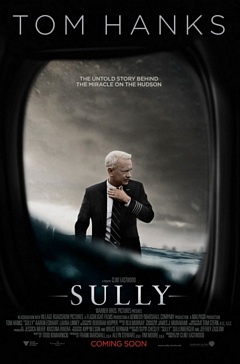I recently watched Sully (2016,) the overrated Clint Eastwood-directed drama about the US Airways Flight 1549 incident, aka the “Miracle on the Hudson.”
 In summary, on 15-Jan-2009, Captain Chesley “Sully” Sullenberger (played by Tom Hanks) heroically dead-sticked his Airbus A320 aircraft in New York City’s Hudson River after both the aircraft’s engines failed from a bird strike. He then helped get passengers and crew off uninjured.
In summary, on 15-Jan-2009, Captain Chesley “Sully” Sullenberger (played by Tom Hanks) heroically dead-sticked his Airbus A320 aircraft in New York City’s Hudson River after both the aircraft’s engines failed from a bird strike. He then helped get passengers and crew off uninjured.
Sully centers on Sullenberger’s post-decision dissonance. To spin the real-life six-minute flight and the 24-minute swift rescue into a 96-minute Holyrood extravaganza, the filmmakers devised an antagonist in the form of National Transportation Safety Board (NTSB) investigators who try hard to blame Sullenberger for the mishap.
Overdramatized Portrayal of the NTSB Investigators
On the screen, the smirking NTSB investigators use flight simulators and computer analysis to second-guess Sullenberger’s lightning-quick decisions. They would have rather he made it to an airport nearby—a possibility that he had instantly judged was not viable given his 40 years of flying experience.
Contrary to Sully‘s portrayal, the NTSB was unequivocal that landing the aircraft on the Hudson was the right call. In his memoir, Highest Duty: My Search for What Really Matters (2009,) Sullenberger mentions that he was “buoyed by the fact that investigators determined that [first officer] Jeff and I made appropriate choices at every step.”
In the course of the real-life 18-month investigation of Flight 1549, the NTSB did investigate the odds of landing the aircraft in a nearby airport. Exploring all possible flaws that contribute to a crash is part of the NTSB’s charter. The NTSB, like other accident-investigation agencies, concerns itself principally with preventing future accidents. It rarely seeks to assign blame, nor does it make the pilots justify their actions.
The Complex Leadership Requirements of Flying
Apart from the sensationalized portrayal of the NTSB investigators, Sully misses the opportunity to call attention to the complex leadership requirements of aviation. Flying a civil aircraft is characterized by a high level of standardization and automation, while still placing a strong emphasis on formal qualification and experience.
Today, highly trained pilots have to work with ever more complicated and autonomous technology. The routinization must be weighed up against deliberate action. On Flight 1549, the A320’s much-studied fly-by-wire system allowed the pilots to concentrate on trying to resurrect the engines, starting the auxiliary power unit (APU,) and deciding the flight path in the direction of the Hudson. Airbus’s legendary computer controls will not allow the pilots to override the computer-imposed limits even in an urgent situation. Sullenberger and others have commented that lesser human-machine interaction may perhaps have allowed him a more favorable landing flare and helped him temper the aircraft’s impact with the water.
Aircrews now consist of ad hoc teams working together typically only for a few flights. They build their team quickly and rely on the crew’s collective knowledge and experience to round out the high levels of standardization.
Due to the complex demands for leadership in aircrews, specialized training programs such as Crew Resource Management (CRM) are in place to improve crew communication, situational awareness, and impromptu decision-making. These systems were established to help crews when technical failures and unexpected events disrupt highly procedualized normal operations.
Furthermore, individual and organizational learning from accidents was institutionalized through mandatory reporting of incidents—not only within the airline involved but also across the aviation community.
Leadership Lessons on Acting Under Immense Pressure: The Context of Success
Owing to intuition, experience, and quick coordination, Sullenberger was able to “land” the aircraft on the Hudson within four minutes following the bird strike and have his passengers and crew quickly evacuated onto the aircraft’s wings and onto rafts.
The rapid and highly complex coordination required for this extraordinary achievement was only achievable because of exceptional leadership, exemplary decision-making under stress, and the technical skills of both the cockpit- and cabin-crew.
The pilots were highly experienced—Sullenberger even had experience as a glider pilot. Further contextual factors—the calm weather on that afternoon and the proximity of NY Waterway ferries—helped bring this accident to a good end. All this facilitated the almost immediate rescue of passengers and crew from the rapidly sinking aircraft and the frigid water.
.jpg) On Another Note, Sullenberger’s memoir, Highest Duty (2009,) is passable. The most interesting part of the book is the last fourth, where he discusses Flight 1549 and what went through his mind. Interestingly, Sullenberger writes that even after he realized that the plane was in one piece after hitting the water, he worried about the difficulties that still lay ahead. The aircraft was sinking: everyone had to be evacuated quickly. The passengers could survive only for a few minutes in the frigid waters of the Hudson.
On Another Note, Sullenberger’s memoir, Highest Duty (2009,) is passable. The most interesting part of the book is the last fourth, where he discusses Flight 1549 and what went through his mind. Interestingly, Sullenberger writes that even after he realized that the plane was in one piece after hitting the water, he worried about the difficulties that still lay ahead. The aircraft was sinking: everyone had to be evacuated quickly. The passengers could survive only for a few minutes in the frigid waters of the Hudson.
.jpg)
.jpg)
 The key to leading a wise and purposeful life is to balance kindness with strength. To be wise and kind,
The key to leading a wise and purposeful life is to balance kindness with strength. To be wise and kind,